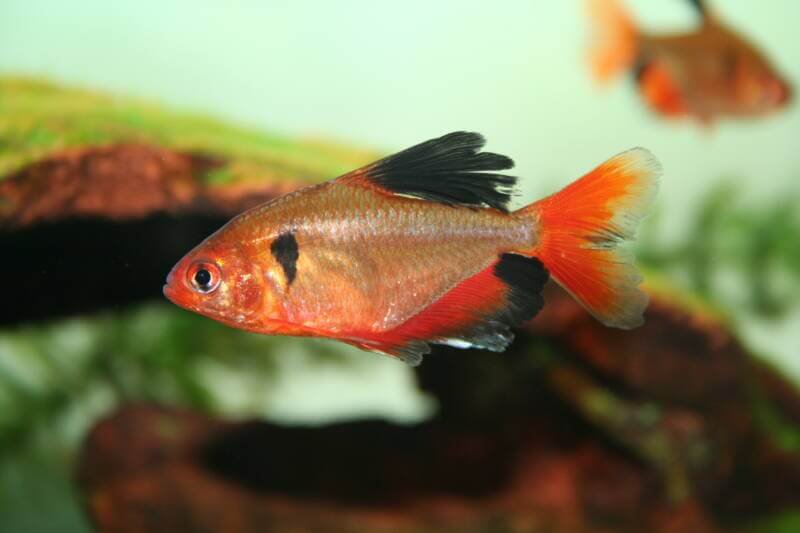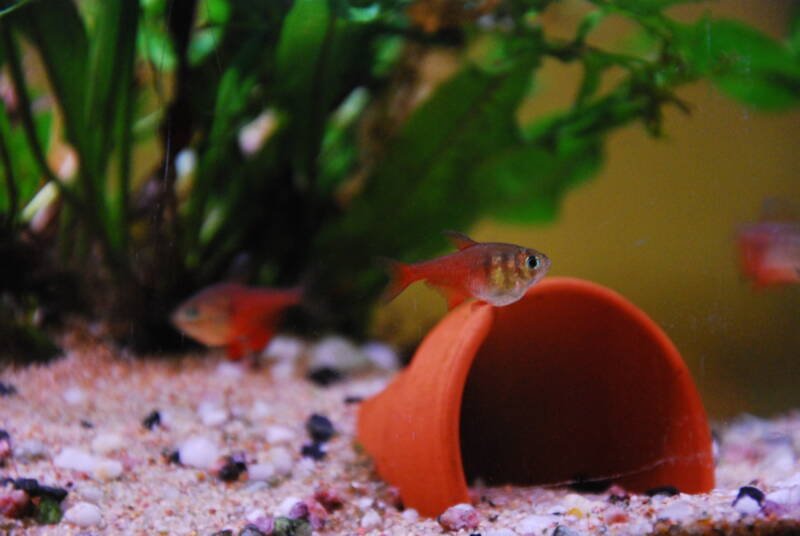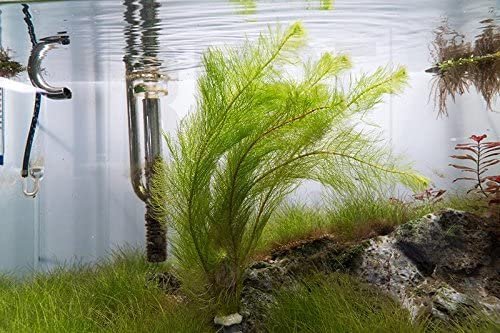The serpae tetra (Hyphessobrycon eques) is a strikingly colored member of the Characidae family.

This freshwater fish is an aquarium favorite for its beauty and playfulness. They are also relatively easy to keep. Read on for more information.
At a Glance
| Tank Size: | 20 gallons minimum |
| Group Size: | 6 or more |
| Water Temperature: | 72 to 79°F (22 to 26°C) |
| pH: | 5 to 7.8 |
| Hardness: | 10 to 25 dGH |
| Lifespan: | 5 to 7 years |
| Breeding: | Egg scatterer |
| Adult Size: | 1.5 inches (3.8 cm) |
| Usual Place in the Tank: | Middle to bottom |
In this article
Natural Habitat
In the wild, serpae tetras are found in South America. They inhabit the rivers of the Guaporé region in Bolivia and the upper Paraguay River basin.
They prefer slower-moving waters found in ponds, lakes, and streams. These waters are darker and have plentiful vegetation.
Serpae tetras tend to stay near submerged roots and vegetation, where they can find both shelter and food.
Appearance and Biology
The first thing you notice about the serpae tetra is its brilliant color. Most of the species are a vibrant red-brown color, with shimmering scales that reflect the light.
This glittering, jewel-like appearance gives the serpae tetra its other common names: jewel tetra and red minor tetra.
Serpae tetras have a black spot just behind the gills. Their dorsal fin is square-shaped and dark black with a slight white edge.
The anal fin is shaped like an elongated triangle and the tail is forked. Both fins are red with black tips.
The vibrancy of the tetra’s colors can grow or fade depending on their health, diet, and environment.
The serpae tetra has a flat and tall body shape. There is not much variation between males and females of the species.
Females can be slightly less vibrant in color and rounder when carrying eggs.
Size
Expect your serpae tetra to grow to a length of 1.5 inches (3.8 cm) as an adult.
Lifespan
A serpae tetra can live anywhere from five to seven years. As with all fish, diet and environment can affect the lifespan of your fish.
Behavior
Serpae tetras do have a reputation as fin nippers. Keeping a group of six or more tetras together may reduce the odds of this happening.
This species can be a bit timid, so having plenty of hiding places may increase their comfort and limit any aggressive behavior.
Serpae tetra is a schooling fish. Your group of these tetras will generally stay in the middle to bottom tank areas.
They like to chase each other and will generally leave other fish alone. Having a tank with objects they can explore will keep them interested.
This species swims in a unique manner that is best described as “jerky.” They are fast swimmers that will speed for a short time, stop, and speed off again.
How many per gallon?
Because this species does best in a group of six or more, plan on a minimum tank size of 20-gallons.
This will allow space for these active swimmers to explore as well as room for plants and objects along the tank bottom.
Tank Setup
Setting up your fish tank to accommodate serpae tetras is simple.
Decorations

Line your 20-gallon tank with a dark, sandy substrate. Decorate with both live aquarium plants and driftwood or rocks along the edges to give your serpae tetras places to hide.
Consider java moss or Myriophyllum to provide shelter for your fish.

Keep the plants and decorations along the edges and the middle of the tank clear for swimming.

Water Conditions
Do not introduce your serpae tetra to a freshly set-up tank. They are sensitive to water parameter fluctuations, so a mature tank is best.
Using blackwater extract or peat can help keep the water soft and acidic.
Maintain the pH level between 5 and 7.8 and the temperature between 72 to 79 degrees Fahrenheit (22 to 26°C). Water hardness should be between 10 to 25 dGH.
Equipment
Install a canister filter that permits slow water movement. Use lower-powered lighting to better replicate their natural habitat.
Tank Mates
As we have mentioned, to keep your fish happiest and healthiest, they need other serpae tetras. A group of at least six is best.
Keep your tetras with other fast-swimming fish. They may nip at the fins of slower-swimming, long-finned fish.
Consider the following to pair with your serpae tetra:
- Barbs
- Danios
- Tetras (cardinal, black skirt, bloodfin, or neon tetra)
- Loaches or catfish
Avoid the following:
Food and Diet
Serpae tetras are omnivores. They will readily eat commercial flake and pellet food.
To keep them healthiest, augment their diet with freeze-dried, frozen, and live foods. Give them bloodworms or brine shrimp on occasion.
Breeding
To breed your serpae tetras, first prepare a separate tank with plenty of plants.
Consider adding a breeding mop. The serpae tetra is an egg scatterer, so the plants and mop will help to protect the eggs.
Keep the water pH level at 6.0 and raise the temperature to around 80 degrees Fahrenheit (26.7°C). Water softness should be between 6 to 8 dGH.
Condition your breeding pair with protein-heavy, live foods then move them to the breeding tank.
Watch for breeding behavior. The male will chase the female, who will scatter eggs as the male fertilizes them.
Remove the adults soon after this is complete as they tend to eat the eggs. The eggs will hatch in two days. At first, the fry will eat their egg sacs.
Once they become free swimming, you can feed them infusoria and baby brine shrimp.
Hardiness
While serpae tetras are not susceptible to any unique diseases, they can contract common freshwater fish diseases.
Ailments include ich, parasites, and fungal infections. You can prevent most of these by maintaining tank and water conditions.
Feeding your fish a healthy, varied diet improves their resistance to disease.
If your fish come down with any of these ailments, correct any water condition issues and use available medications.
Frequently Asked Questions
Are Serpae tetras aggressive?
Serpae tetras are a peaceful species and get along well with other fast-swimming fish. They do tend to nip at long-finned or slow-swimming fish.
Are Serpae tetras fin nippers?
While serpae tetras have a reputation as fin nippers, you can typically prevent this by keeping them in groups of six or more.
Will Serpae tetras eat shrimp?
Serpae tetras can eat shrimp. If you plan on keeping them in the same tank, add live plants to give the shrimp places to hide.
How big to Serpae tetras get?
Serpae tetras grow to a length of 1.5 inches (4 cm).
Will Serpae tetras school with other tetras?
Yes. Serpae tetras will school with other, fast-swimming tetras, such as the cardinal or neon tetras.
Final Recommendations
The serpae tetra is, without a doubt, a beautiful addition to a community aquarium.
Remember that for the best health of your fish, keep a group of at least six fish and feed them a varied diet.
The cost per fish online can vary from under $2 to over $4.
Plan your aquarium layout to give clear areas for swimming and planted areas for shelter.
Monitor water parameters and always introduce your fish to a mature tank.
What are the best tank mates you have paired with your serpae tetras?